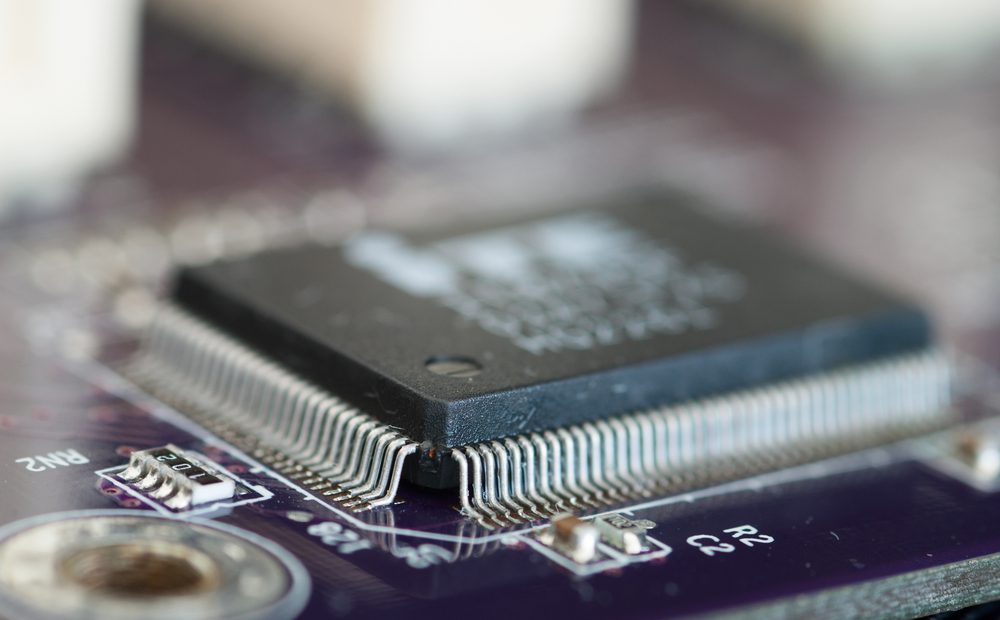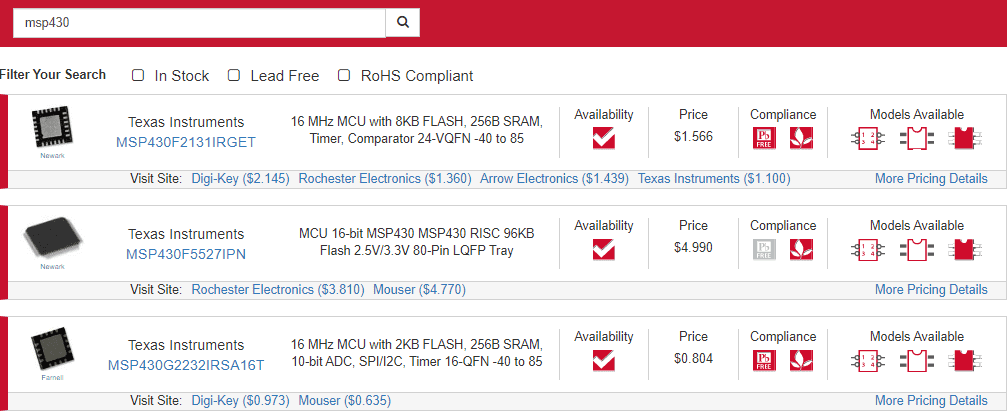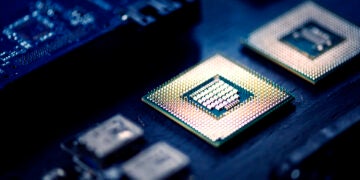
When you think of embedded systems, plenty of different applications come to mind. Anything from a programmable microwave to an electronic control unit in an automobile qualifies as an embedded system. Each of these applications needs a different type of processor to provide its functions. For smaller devices like wearables and always-on products, you’ll need a low-power microcontroller (MCU) with wake-up functions, high I/O count, and an integrated analog-to-digital converter (ADC).
The MSP430 MCU from Texas Instruments fits nicely in these application areas. Anything requiring interfacing with multiple sensors or external devices—while also providing low power consumption in standby mode—falls into MSP430 applications. If you’re looking for an MCU for your next project, we are going to discuss why you should consider the MSP430 MCU and where you can find CAD models for your components.
MSP430 Specifications
The MSP430 from Texas Instruments is an MCU with standard RISC architecture, but it comes in multiple variants. Each variant has the same general set of features but different electrical specifications. This gives designers plenty of options for building low-power embedded systems on a proven platform.
Perhaps the most important specification of an MSP430 is its low power consumption, with current draw reaching below 1 μA in standby mode. Once the device is brought out of standby, it has an extremely fast wake-up time of ~1 ms. This extremely low response time is critical for ensuring a smooth experience when the device needs to receive an input from a user. It’s also important for applications requiring interfacing with sensors, as the device might need to respond to sensor input, rather than user input.
Onboard Features
The onboard features and specifications for the MSP430 vary widely. For example, the most basic MSP430 variant (MSP430x1xx series) can have as little as 128 bytes of RAM, but it includes a 12-bit SAR ADC. Higher-end variants mix and match different specifications, such as combining higher memory and I/O count with a smaller ADC (e.g., 430x6xx series). The table below summarizes some important specifications you’ll find in MSP430 datasheets:
| Feature/Spec | Maximum Value |
| Supply Voltage | Up to 3.6 V |
| Current Draw | ~500 nA (standby mode) or <1 mA (operational) |
| Wake-up Time | <1 ms from standby mode |
| RAM Retention Current | ~100 nA (standby and operational mode) |
| Flash Memory | Up to 512 kB (430x5xx and 430x6xx series) |
| RAM | Up to 66 kB (430x5xx and 430x6xx series) |
| Bit depth | 8, 16, or 32 bit |
| GPIO Count | Up to 90 pins (430x6xx series) |
| Other Interfaces | UART/SPI/I2C |
| Clock Frequency | Up to 25 MHz (430x5xx and 430x6xx series) |
| Packages | DIP packages, QFP packages, TSSOP, BGA, SOIC |
As a mixed-signal MCU, the MSP430 includes an ADC for interfacing with analog sensors. The ADC channel number, architecture, and bit depth also vary across different components. Channel count reaches up to 16 on high pin count variants with 10, 12, or 14 bit accuracy. SAR or Sigma-Delta is used for the ADC architecture.
Programming
Although the electrical specifications are slightly different for each variant, the system you build will rely on common IDE, libraries, and firmware. Once you choose an MSP430 variant for your product, you’ll be able to begin programming your new device quickly with a set of software tools provided by the manufacturer. Also, the common architecture and firmware allow your code to be compiled to a new variant if you ever decide to upgrade your product.
CC430 SoC Variant
The CC430 follows Texas Instruments’ trend of providing greater integration between standard MCUs and other features. The CC430 is a monolithic system-on-chip (SoC) that integrates a standard MSP430 MCU with an RF transceiver for sub-1 GHz wireless communication. This variant enables radio communication over proprietary protocols with 2-FSK, 4-FSK, GFSK, MSK, or OOK.
Some MSP430 Applications
With all the different MCUs on the market, it can be difficult to see which applications are ideal for different components. There is a good reason for this, as MCUs are intended to be more or less general-purpose components for embedded computing. However, if you look through a datasheet, you can divine some MSP430 applications for different types of products.
The integrated ADC, high I/O count, and integrated high-speed interfaces enable applications where the MSP430 provides control over a larger system while collecting data from analog sensors. Add the low power consumption across all variants, and you have a versatile component forming the foundation of a new embedded product. Some basic applications of the MSP430 include:
- Always-on devices. The low power consumption of the MSP430—combined with its highly integrated nature—allows a designer to create always-on products, which can then respond to user and/or sensor inputs.
- Master MCU for other peripherals. The high I/O count allows the MSP430 to be used as a master MCU, which then controls other digital peripherals in the system via GPIO or other high speed interfaces.
- Wireless networks. Sensor networks in different environments are all the rage these days, and an MSP430 variant can be used for data collection at an IoT node/endpoint. Simply add a standard transceiver and antenna to the board, and you can quickly create a network of new devices.
Getting an MSP430 variant into your board takes the right set of search and comparison features to look through the broad range of specifications. You’ll also need 2D and 3D CAD models for use in your PCB design software. Rather than create PCB footprints from scratch, or search online for unverified CAD data, the right search engine will give you access to the MSP430 footprints you need alongside datasheets, sourcing information, and pricing.

Whether you’re designing for sensor fusion or low-power always-on devices, implementing MSP430 applications takes the right component models. The component search feature in Ultra Librarian helps you easily search a range of parts and locate verified CAD models in vendor-specific and vendor-neutral file formats, all at no cost to you. Once you find your component footprints, they can be imported into popular ECAD applications. You’ll also be able to see up-to-date sourcing information from authorized worldwide distributors for all your components.
Ultralibrarian can help you find the right components to implement MSP430 applications. The search features in our library help you easily sift through a range of parts and locate verified CAD models in vendor-specific and vendor-neutral file formats. Register today for free!








